Fungi are some of the most interesting and unusual creatures on Earth. There are so many different types, and each one has its own unique features and habits. One of the more peculiar fungi is Amanita pantherina – also known as the panther cap fungus.
This strange creature has a vibrant brown cap with distinctive white spots, giving it its characteristic ‘panther’ appearance. Amanita pantherina is found all over the world, and can be dangerous if eaten raw. But what exactly does this weird fungus do? Let’s take a closer look!
Amanita Pantherina – History
Amanita pantherina contains the psychoactive compound, muscimol. It is a potent agonist of the GABA-A receptors. When consumed, it can cause hallucinations, delirium, and euphoria. In high doses, it can be fatal. Panther amanita also contains ibotenic acid, which is a neurotoxin.
There are several documented cases of people dying after consuming amanita pantherina. In most cases, the victims were not aware of the mushroom’s toxicity. In some cases, the victims were unaware that they had consumed a poisonous mushroom at all.
Pantherina has been used for centuries in traditional medicine as a treatment for various ailments. In recent years, it has been studied for its potential anti-cancer properties. Pantherina has a long history of use in folk medicine. In Russia, it was used to treat epilepsy and toothaches. In Sweden, Pantherina was used as a sedative. In Germany, it was used to treat nervous disorders.
Pantherina is considered to be a poisonous mushroom and should not be consumed. If you suspect that you or someone else has ingested this mushroom, seek medical attention immediately.
Amanita Pantherina Mushroom – Identification Guide
Amanita pantherina, also known as the false blusher due to its similarity to the true blusher mushroom, is a species of fungus in the Amanitaceae family. The fruit bodies have a convex to flattish cap that is brownish-red in color with a distinctive white rim.
The gills are free and white, while the stem is up to 5 in tall and 0.4–0.8 in thick. The cap is convex to flattish in shape, and has a distinctive white spots looking like warts. The spore print is white, and the cap color is from hazel-brown to pale ochraceous brown. The flavor is mild, sweet, and light, similar to a radish or raw potato.
Habitat
The panther mushroom is found in woods and meadows across Europe and Asia. It typically grows in areas with deciduous trees, such as oak and beech forests. The mushroom can also be found in grassy areas, such as pastures and fields. This fungus prefers to grow in cool, damp environments.
The amanita pantherina mushroom is a mycorrhizal fungus, meaning that it has a symbiotic relationship with the roots of trees. The tree provides the mushroom with nutrients, while the mushroom helps the tree to absorb water and minerals from the soil. This relationship is essential for the health of both the tree and the mushroom.
Panther Cap – Toxicity
Amanitas pantherinas are considered to be one of the most toxic species of Amanita mushrooms. They contain high levels of toxins that can cause serious illness or death in humans if consumed. Symptoms of mushroom poisoning can include vomiting, diarrhea, cramps, and seizures. In severe cases, liver and kidney failure may occur. There is no known antidote for amanita pantherina poisoning and treatment is typically supportive.
Amanita pantherinoides is much more toxic than amanita muscaria (fly agaric). Pantherina is often confused with the edible mushroom Paddy straw (Volvariella volvacea). As a result, accidental ingestion has occurred when people mistake Pantherina for Paddy straw.
If you think you have ingested this mushroom, seek medical attention immediately. Panthercap may look intriguing, but it’s a toxic mushroom with strong psychoactive effects and serious toxic effects that may even lead to death.
Ibotenic acid and muscimol are the primary psychoactive chemicals in amanita pantherina. Both of these chemicals are structurally similar to glutamate, a neurotransmitter in the brain that plays a role in learning and memory. When these chemicals bind to receptors in the brain, they can cause changes in perception, mood, and thought.
Similar Posts:
- Amanita Gemmata: A Tricky Mushroom Worth Discovering
- Amanita Muscaria: All You Should Know About Fly Agaric Poisonous Mushroom
- Psilocybe Subaeruginosa: Magic Mushroom From Australia. Spore Prints, Cultivation, Psilocybin Content
- Psilocybe Caerulipes – Description of a Magic Mushroom, Its Potency and Habitat
- Pluteus Salicinus Mushroom: About the Willow Shield Shroom (Knackers Crumpet)
- Pluteus Americanus Mushroom: Characteristics, Habitat, Morphology, Growth, Legality & Benefits
- Psilocybe Baeocystis – Unusual Psilocybin Species. Identification, Potency & Characteristics





